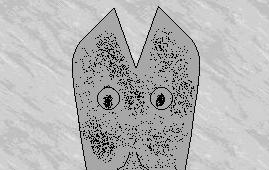Conversation as an art form was most popular at the turn of the last century, when it seemed that anybody with a mouth and an opinion could claim to be an accomplished artist in the field. At that time, conversation was second only to comic opera as the foremost means of self-expression.
Since then, conversation has steadily declined as an art form. The disarray in which the conversational arts presently exist is seen by many conversation critics and denture wearers (often one in the same) to be as much a symptom of the decline of the western civilization as the popularity of Pee-Wee Herman.
The proliferation of other art forms in the 20th century is largely responsible for the decline in a number of ways. Artists who used to spend their entire lives developing their conversational artistry now devote themselves, instead, to the far more accessible fields of television, the cinema and paperback romance novels.
Especially paperback romance novels.
(The British Lord Athol Twittden, who is considered by many critics to be the last great conversational artist, has said: “Conversation is degenerating at just the time that we need it most… Is sitting in front of a big box really as emotionally satisfying as showing off your intelligence by completely destroying Freudian psychological theory in a conversation that last several days? I hardly think so. But, then again, I have yet to own a cordless converter…”)
The newer art forms have also debased the form of the artistic conversation. At the height of the art form’s popularity, a typical conversation would last over three hours, and include such topics as: the meaning of life, the latest play at the Savoy, the existence of god, the unnatural habits of the people down the lane, the viability of the continued existence of the Monarchy, the struggles of the emerging middle class, the authorship of Shakespeare’s plays and the availability of a good wine for the evening’s meal. A conversation that did not turn to more than six subjects was rarely a critical success.
Today’s conversations barely last more than five minutes, on average, and often centre around other art forms, particularly television. The following is a not uncommon form for such a conversation to take:
“Hello?”
“Hi.”
“How are you?”
“Good. How are you?”
“Fine. Did you see Magnum last night?”
“Yeah. Wasn’t it amazing?”
“Yeah. (pause) Well, I gotta go.”
“Okay. Bye.”
“Bye.”
Seventeen seconds. Thirty words. Such a conversation would not be fit as a trailer for any of the great conversations of the past! Why, a great critic of days gone by, a Micheline or a Kroetzburg, would laugh if such a conversation had been brought before him! And, yet, such conversations make up the bulk of the art today.
Part of the problem in the decline of the conversational arts is in the decline of conversational criticism. Critics no longer appear to be interested in detailed analysis of content, some minimalist critics abandoning it totally for the more esoteric consideration of form.
“Nobody has the time any more,” critic Alan Freed explained,” either to devote several hours to a conversation, or to take the thousands of hours to educate themselves to a level where they can carry on such a conversation. Let’s face it: almost all of the great conversational artists were from the upper classes, and had all the time they needed to perfect their craft…”
To stop the imminent extinction of conversation as an art form (last year, only three conversation guilds remained in existence in Canada), many governments are setting up museums and galleries devoted to the art. It is their hope that public interest can be encouraged through the preservation and restoration of the world’s great conversations.
Freed doesn’t see much hope in this. “School children and academics,” he argued, “Are the only one who will go to such galleries, and it is difficult to believe that many of them will go out of genuine interest.” Freed then started talking about the need for schools for conversationally gifted children, steel production in Latin America and a variety of other subjects. He apparently went on long after we had left.
Is the art of conversation dying? Could government intervention help prop it up, or would that just delay the inevitable? One thing is certain: this is one of the few cases where an artistic problem may well be solved by a lot of talk.
(For more information on the conversation as art form and the history of conversation, contact the Moribund Forms of Communication Department of the Canada Council through your local Member of Parliament.)


